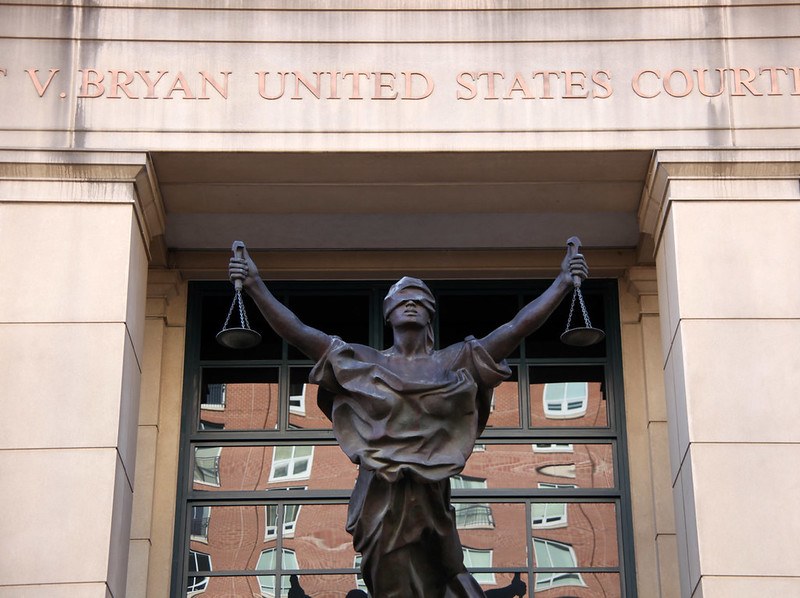Comey, James, and ‘Animus Through a Megaphone’
-(2)-(2).jpg?sfvrsn=69965fad_5)
Published by The Lawfare Institute
in Cooperation With

James Comey and Letitia James both know that getting a case dismissed for selective and/or vindictive prosecution is typically a tall order for a defendant. They say as much in their respective motions requesting just that. They also both point out why this time might be different: As James’s motion colorfully puts it, “Here, the Executive has shouted six years of direct evidence of genuine animus through a megaphone.”
The manner in which the two separate filings chronicle this animus is similar—and similarly striking. But the differences reveal almost as much. They show the breadth and depth of the manners in which the current Justice Department has perverted the prosecutorial process to satisfy a president seeking retribution against his political enemies.
Selective and/or Vindictive Prosecution
The word “vindictive” seems to perfectly describe President Trump’s prosecutorial campaigns against his longtime adversaries—to a layman, at least. Legally, however, the bar for dismissal for selective or vindictive prosecution (separate flaws, though often coupled by defense teams) is high.
As Ema Rose Schumer writes in Lawfare, safeguards against vindictive prosecution are rooted in the Due Process Clause. To prevail on such a claim, a defendant must either prove that charges were directly in retaliation for exercising a legal right or “show facts sufficient to create a ‘realistic likelihood of vindictiveness,’” at which point the government must justify its decision to bring a case as reasonable. Another common way of putting it: The defendant has to show he wouldn’t have been prosecuted “but for” the vindictive motive.
Selective prosecution draws on the Equal Protection Clause principle that the government can’t discriminate between “similarly situated” defendants: prosecuting one member of a class while neglecting to prosecute others outside that class who may have broken the same rules. Here, a defendant must show that the prosecution had not only a discriminatory effect but also a discriminatory purpose—that a case was brought “because of” a protected characteristic or activity rather than “in spite of” it.
In Oyler v. Boles, the Supreme Court found that protected characteristics for these purposes could be “race, religion, or other arbitrary classifications.” Protected activity, meanwhile, is usually a constitutional prerogative such as the First Amendment’s guarantee of free expression, though, according to Comey and James, statutory duties also count—duties like carrying out one’s professional responsibilities as FBI director or New York attorney general.
“I’M COMING AFTER YOU!”
Comey and James both set about establishing the retaliatory nature of the charges against them by cataloguing President Trump’s relentless insults and his demands for “justice” to be served against them. For Comey, six years of direct evidence of animus are nothing; Trump has been railing against him for almost a decade now. The 60-page appendix of attacks—tweets, throwaway lines at rallies, and more—accompanying his motion reflects this extended timeline.
“This is an extraordinary case,” attorney Michael Dreeben said in his argument for the defense during a Nov. 11 hearing on the motion, “and it merits an extraordinary remedy.”
The tale begins in May of 2017, a week before Comey was fired as FBI director, with a missive reading, “FBI Director Comey was the best thing that ever happened to Hillary Clinton in that he gave her a free pass for many bad deeds! The phony…”—an apparent reference to Comey’s supervision of the “Midyear Exam” investigation into Hillary Clinton’s alleged mishandling of classified information as secretary of state.
The intervening years of rants and raves make clear precisely what has angered Trump: not just “Midyear Exam,” but “Crossfire Hurricane”—or what he calls the “Russia Hoax.” Comey’s own critiques of Trump (“a person… for whom affirmation is like oxygen”; “a near-existential threat to the rule of law”; “a strange and slightly sad old guy yelling at you to get off his lawn, echoed by younger but no less sad people in red hats”) only fueled the president’s fury.
What did the president want done about this? That’s also no secret. The Comey story ends this September with a series of Truth Social tirades, including a now-notorious post addressed to the attorney general, or “Pam”:
What about Comey, Adam ‘Shifty’ Schiff, Leticia [sic]??? They’re all guilty as hell, but nothing is going to be done… We can’t delay any longer, it’s killing our reputation and credibility. They impeached me twice, and indicted me (5 times!), OVER NOTHING. JUSTICE MUST BE SERVED, NOW!!!
Finally, Trump celebrated the indictment that the Justice Department eventually secured:
The level of enthusiasm by the FBI was incredible, but only caused by the fact that they knew Comey for what he is, and was, a total SLIMEBALL! Again, thank you to the FBI and, specifically, those that worked on this case with U.S. Attorney Lindsey Halligan, and the DOJ.
During the hearing, the defense emphasized that there is a deeper pattern to the case than intermittent flurries of vituperative tweets. Instead, every time Comey expressed one of his opinions—from his initial testimony before Congress on the heels of his fire; to his book, “A Higher Loyalty”; to his remarks about Trump’s fitness for office surrounding the 2024 election—he triggered a barrage of vulgar and venomous responses from the president that often included calls for his jailing. In contrast, when Comey went silent, “so did the president.” This persistent phenomenon of action and reaction, Dreeben said, reveals that Trump hoped to use the “awesome weight of threatening to deprive somebody of liberty as a means of deterring somebody from speaking out, punishing their speech and expressing personal animosity.”
Unsurprisingly, the animus explicated in James’s motion broadly matches—even if the particulars vary. She has managed to amass an impressive 113 pages of examples of Trump’s animus toward her, perhaps to compensate for the shorter period during which she has been on his list of adversaries. Her hearing will take place on Dec. 5.
James’s tale starts with her pursuing the Trump Organization on charges of illegally inflating the value of various assets. Soon after her investigation began, Trump retweeted legal “analysis” from conservative influencers:
AG Letitia James of New York is abusing her power by targeting the POTUS. Using the Attorney General office as a weapon to deliberately target the President because of Political Bias should be against the Law and a violation of the Hatch Act!
This marked the beginning of a flurry of tweets about James—nine in the next two days, the motion says—including odd monikers (“Letitia ‘Peekaboo’ James”) and other name-calling (“racist,” “fraud”) as well as 14 calls for her prosecution leading up to his trial. One of these is practically the dictionary definition of retaliatory: “IF YOU GO AFTER ME, I’M COMING AFTER YOU!”
“JUSTICE MUST BE SERVED, NOW!!!”
Even extensive records of animus as exuberantly articulated as President Trump’s aren’t necessarily enough to win on a motion to dismiss for selective and/or vindictive prosecution. When it comes to showing that the government had no reasonable basis to bring a case—and that, indeed, it wouldn’t have brought a case if not for the chief executive’s desire for revenge—Comey and James’s arguments aren’t just similar. They’re nearly identical.
The post addressed to “Pam”—apparently intended as a direct message—represents only one instance in a highly unusual series of events culminating in the indictments of both defendants.
The abridged version goes something like this: Then-interim U.S. Attorney for the Eastern District of Virginia Erik Siebert didn’t believe there was a strong enough case against Comey or James, and so failed to bring charges. Indeed, in both cases career prosecutors reportedly penned what are known as declination memos—which are exactly what they sound like. Those most closely acquainted with the evidence and with the law declined to bring charges. (The question of whether a declination memo was indeed penned in the Comey case featured prominently in the Nov. 19 hearing: The counsel for the government refused to answer “yes” or “no” to the query, eventually admitting that he had been instructed to keep his knowledge to himself by the Office of the Deputy Attorney General.)
The president then insisted that charges be brought regardless. After Trump said he wanted Siebert “out,” Siebert resigned—and was replaced with Lindsey Halligan, an insurance lawyer. Career staff remained uncomfortable working on either case, so they were fired, too, and Halligan presented to the grand jury herself.
All the while, Trump very publicly implied—in the Oval Office as well as on Truth Social—that the reason he removed one prosecutor with decades of experience and replaced him with a non-prosecutor with scarcely any experience at all was because he wanted cases brought against his enemies, and fast. Both motions to dismiss make the point that Halligan, previously the president’s personal attorney, was installed as a “stalking horse” to carry out his agenda. They argue that because she was acting as his agent, she need not have displayed any animus of her own; his is sufficiently incriminating. This contention cropped up in the Nov. 19 Comey hearing—with Judge Nachmanoff asking whether the term “puppet” could also, “for lack of a better word,” describe Halligan’s position. The defense demurred and the prosecution dissented.
Judge Nachmanoff also brought up, multiple times, a statement Trump made to a gaggle of reporters: “We have to act fast. One way or the other. They’re guilty, they’re not guilty. We have to act fast,” Trump said. “If they’re not guilty, that’s fine. If they are guilty, or if they should be judged, they should be judged. And we have to do it now.” Pressed on the propriety of the sentiment, the government said that even if it was improper the defense would have to prove Halligan had his thinking in her own mind.
All this is, of course, a departure from the typical course a case takes from investigation to indictment. The oddities, common to both cases, tend to suggest neither would have made it in front of a grand jury without intervention from a vengeful chief executive. Dreeben summed it up neatly: The president has “declared himself to be the chief law enforcement officer of the United States”; the attorney general has shown herself to be “highly responsive to the president’s directives”; the U.S. attorney for the Eastern District of Virginia “did what she was told to do.” So, no, Trump “didn’t go into the grand jury, but exercising the authority that’s vested in him, he brought about the prosecution.”
The Comey and James prosecutions also include specific irregularities, varying in their particulars but painting the same bigger picture. Comey, for his part, points to the atypically long time Halligan spent in the grand jury room—keeping the grand jury there “well past normal court hours” and receiving a “no true bill” on the first count before finally emerging with a true bill on two others by the slimmest of majorities. Indeed, Comey recently prevailed on a separate motion asking for disclosure of grand jury materials. The remedy, United States Magistrate Judge William E. Fitzpatrick acknowledged, is “extraordinary”—but so may have been the prosecutorial misconduct. (Judge Nachmanoff has stayed Fitzpatrick’s order to give the government a chance to brief its objections.)
Not only was attorney-client privileged information possibly improperly protected, but statements Halligan made to the grand jury “on their face appear to be fundamental misstatements of the law that could compromise the integrity of the grand jury process,” Judge Fitzpatrick found. Furthermore, inconsistencies in the government’s account of the grand jury proceedings present the possibility that “the indictment returned to the judge was not the same as the one presented to and deliberated upon by the grand jury,” placing the court “in uncharted legal territory.”
Judge Nachmanoff further probed this matter in the hearing on vindictive prosecution, leading to the eventual revelation that the full grand jury had not in fact voted on or even seen the final indictment—essentially a revision of the original indictment, but with the count the grand jury no-billed removed so that only the counts it had true billed remained. The defense argued this was, in itself, grounds for dismissal.
The grand jury irregularities are, again, the subject of a dispute distinct from the motion to dismiss for vindictive prosecution, but they are elucidating nonetheless. Any prosecutor familiar with the grand jury process—and not installed with the express purpose of securing an indictment at all costs—likely would have remained within the borders of the modern justice system. The defense suggests as much in its motion for disclosure, saying it is “evident” that Halligan’s “inexperience affected the grand jury proceedings.” And an indictment bolstered by strong evidence likely wouldn’t have invited the confusion that these shakier accusations seem to have produced in the grand jury process.
The James case has its own procedural and substantive peculiarities, as laid out in her motion. The criminal referral that prompted the investigation focused on multiple properties whose mortgages James had purportedly obtained illegally. But in the end, she was indicted for conduct involving another property altogether. What’s more, this referral came from Federal Housing Finance Agency (FHFA) Director Bill Pulte, who arguably doesn’t have the authority to make such a referral to begin with. The FHFA’s inspector general was also ousted this month after he reportedly attempted to provide constitutionally required information to Eastern District prosecutors—an effort with which the FHFA reportedly was not cooperating. This information might have been so-called Brady evidence—or exculpatory evidence that must be disclosed to the defense.
Many of these details are relegated to the footnotes in James’s selective and/or vindictive prosecution motion, but they are front and center in another motion she filed this week to dismiss the case against her for “outrageous government misconduct.”
This newer motion says that Pulte’s criminal referral, unless the FHFA director “took it upon himself to purchase…documents from various county clerk offices,” may have been based “exclusively on a single fringe blogger’s ‘evidence’” or on unlawfully accessed Fannie Mae files. The material the inspector general was trying to transmit, the motion claims, was an internal complaint by members of the Fannie Mae ethics and investigations unit about this possibly improper access. About a dozen members of the unit were fired after submitting their complaint. (Yet another motion filed by James indicates that discovery included “communications among Fannie Mae investigators calling into question whether there was ‘clear and convincing evidence’ of any ‘occupancy fraud,’”—and speculates that the grand jury may not have been told of this fact.)
And when the contents of the criminal referral weren’t enough, Pulte sent a “private letter to Ms. Halligan providing a summary of information and financial calculations on the Peronne Property”—the home ultimately covered in the indictment.
One last curio in the James prosecution is not something, but someone: so-called Special Attorney for Mortgage Fraud Ed Martin. The existence of this role is itself remarkable, as are the circumstances surrounding it: Martin took on the title this summer after, according to the defense, it became obvious that career prosecutors in Virginia weren’t pursuing the James case with enough vigor to please the White House. His interpretation of his brief apparently included appearing outside James’s house in Brooklyn this August dressed in what the outrageous misconduct motion characterizes as an “Inspector-gadget inspired” trench coat; he also wrote to James’s lawyer in a letter devoid of legal arguments that he would regard her resignation as “an act of good faith.” That language suggests, again, that the aim here was to punish James in one manner or another, rather than to safeguard the rule of law.
The other impediment overcome by this administration’s prosecutorial ingenuity—one shared between the cases—was the statute of limitations. There were literally days left during which the government could seek to punish Comey’s conduct that occurred during Trump’s first term—hence the rush to turn Siebert out and put Halligan in. For James, mortgage fraud turned out to be the perfect tool. There, the statute of limitations runs 10 years rather than the standard five.
The fact patterns in the two cases suggest, in short, that the justice system as it is designed to function simply wasn’t sufficient to get Trump the prosecutions he wanted—so he turned to other means.
Two Classes of One
With vindictiveness out of—or in—the way, the next basis on which Comey and James can object to their prosecution is as impermissibly selective. To prove this claim, they must show that they were targeted with both a discriminatory effect and a discriminatory purpose—that the cases against them were brought because of their membership in a certain class, while “similarly situated” individuals in other classes got away with the same behavior scot-free.
Though Trump has baselessly accused James, a Black woman, of being a “racist,” she does not return the insult in her papers. Instead, both she and Comey raise what’s known as a “class of one” claim—arguing that they’ve been singled out based on arbitrary factors such as the exercise of their constitutional rights.
According to the briefs, the constitutional right being punished in both cases is First Amendment speech: Comey’s critiques of Trump after his firing from the FBI, and James’s during her campaign for her current position. James’s motion includes another right—the right and obligation to bring her civil suit against the president once she was in office, which is established by state statutes.
The question of “similarly situated” is a little more complicated. The task for Comey is identifying other people who purportedly delivered false testimony before Congress but weren’t prosecuted—ideally, people in similar positions to his. His filing seeks to accomplish this with reference to officials in the last Trump administration: Jeff Sessions, Scott Pruitt, Tom Price and Steve Mnuchin. Same conduct, same government body, same type of role.
One difficulty for Comey is that other individuals at other times have been prosecuted for lying to Congress. And because lying to Congress is itself rare (at least, that we know of), it’s hard to prove that prosecutions for doing so are rare relative to the number of liars-to-Congress out there. Courts also tend to require circumstances surrounding comparator prosecutions to be almost exactly the same. But as sparse as examples of lies being told to Congress are, there are even fewer examples of lies being told about the leaking of information—and therefore few situations that are actually similar. It is therefore unsurprising that, at the hearing on his motion, Comey’s team focused on vindictiveness and left selectiveness aside.
The matter of James is more straightforward. She has been accused of classifying a home as a secondary residence when really it functions as an investment property—or, slightly more generally, of misclassifying a property’s occupancy type to secure more favorable terms for a loan. Accordingly, her motion identifies other officials whose home-buying activities have received substantial press attention but haven’t come under scrutiny: Ken Paxton, Scott Bessent, and three other members of Trump’s cabinet among them.
The White House responded to ProPublica’s reports of possible mortgage fraud from these individuals as “just another hit piece from a left-wing dark money group that constantly attempts to smear President Trump’s incredible Cabinet members.” The aforementioned special attorney for mortgage fraud was apparently uninterested in pursuing these individuals.
Selective prosecution claims that manage to show discriminatory effect usually struggle with showing discriminatory intent. Yet in both of these cases intent is covered, as in the vindictive prosecution claims, by those same years of genuine animus shouted through a megaphone.
“Guilty as Hell”
Selective and/or vindictive prosecution claims almost never succeed. But these two defendants may beat the odds: The president has furnished them with ample evidence of animus and procedural abnormalities alike—making both Comey and James, depending on how one looks at it, either extremely lucky or extremely unlucky.
Taken together, their motions outline a campaign led from the Oval Office to deploy the justice system against the administration’s political enemies. They argue that the government has gone in search of semi-plausible bases on which to prosecute people the president has preemptively deemed “guilty as hell.”
The similarities between the Comey and James cases help prove the point. The cases are completely distinct in the conduct they cover—but nonetheless they’ve been lumped together in one tweet and one district where a Trump loyalist has conveniently been endowed with the authority to grant his vengeful wishes. The differences, meanwhile, showcase the sheer variety of ways in which the government has been willing to manipulate the justice system to serve its aims.
Trump demanded that justice be served to Comey and James. Now, deliberating on these motions, judges must determine what that actually looks like.





